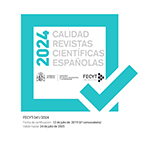De Venecia a Lerma: la recepción vocal e instrumental de Boccaccio. Música, epidemias y canon poético (1500-1650)
Resumen
Entre 1500 y 1650 se sucedieron en el norte y centro de Italia severos episodios epidémicos que transformaron la realidad política, territorial, social, económica y cultural de sus estados. A lo largo de este tiempo los compositores de madrigales integraron de un modo creciente, como respuesta a la realidad vivida, los poemas cantados que cierran las jornadas del Decamerón de Boccaccio, configurándose así un canon que evolucionó a medida en la que nuevos episodios epidémicos golpeaban a la población. Este trabajo se propone delimitar y dar a conocer las fuentes musicales de los textos de Boccaccio durante el periodo examinado, tanto en el ámbito vocal como instrumental, así como su lugar en el espacio de los contrafacta sacros como misas parodia; configurar la evolución del canon poético puesto en música y su difusión –que alcanza hasta la corte del Duque de Lerma en España–, y analizar concisamente las características musicales –factura, forma y género– del mismo como respuesta creativa, interpretativa y expresiva frente al estímulo literario
Descargas
Descarga artículo
Licencia
La revista Cuadernos de Filología Italiana, para fomentar el intercambio global del conocimiento, facilita el acceso sin restricciones a sus contenidos desde el momento de su publicación en la presente edición electrónica, y por eso es una revista de acceso abierto. Los originales publicados en esta revista son propiedad de la Universidad Complutense de Madrid y es obligatorio citar su procedencia en cualquier reproducción total o parcial. Todos los contenidos se distribuyen bajo una licencia de uso y distribución Creative Commons Reconocimiento 4.0 (CC BY 4.0). Esta circunstancia ha de hacerse constar expresamente de esta forma cuando sea necesario. Puede consultar la versión informativa y el texto legal de la licencia.










